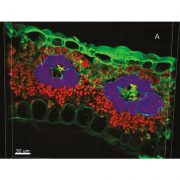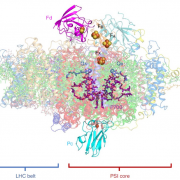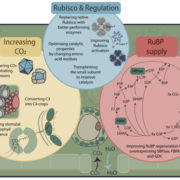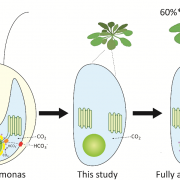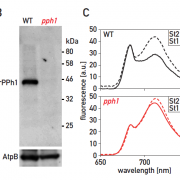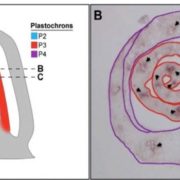What We’re Reading: November 16th
Photosynthesis Special Issue
This week’s ‘What We’re Reading’ summarizes the latest papers from the field of photosynthesis research. This includes a review on the discovery of the Calvin-Benson cycle by Tom Sharkey, and an Expert View on the relationship between nitrogen and photosynthesis by John Evans & Victoria Clarke. There are also summaries of research papers on:
- natural variation in photosynthetic induction rates during shade-sun transitions (William Salter et al)
- a whole plant gas exchange chamber for simultaneously measuring photosynthesis and WUE (Iván Jauregui et al)
- characterisation of the function of the cyanobacterial proteins RbcX (Fang Huang et al) and EcaB (Nan Sun et al)
- debunking the idea that C4 plants are unsuited to growth in cold environments due to insufficient space for rubisco accumulation in bundle sheath cells (Charles Pignon et al)
- further characterisation of the rubisco chaperone BSD2 (Brendon Conlan et al)
And if that’s not enough, see the bottom of this post for nine more photosynthesis papers that we didn’t have time to summarize!
Guest Editor: Dr Mike Page
 Mike is a Senior Research Associate (postdoc) at Lancaster University in the UK, and has been a Plantae Fellow since September 2017. He is a molecular biologist with a background in plant abiotic stress responses, including retrograde signaling pathways in which plastids manipulate nuclear gene expression, and the regulation of antioxidant status by light intensity. He is currently using synthetic biology to build the cyanobacterial carbon dioxide concentrating mechanism in rice plastids, with the ultimate aim of boosting photosynthesis and rice yields.
Mike is a Senior Research Associate (postdoc) at Lancaster University in the UK, and has been a Plantae Fellow since September 2017. He is a molecular biologist with a background in plant abiotic stress responses, including retrograde signaling pathways in which plastids manipulate nuclear gene expression, and the regulation of antioxidant status by light intensity. He is currently using synthetic biology to build the cyanobacterial carbon dioxide concentrating mechanism in rice plastids, with the ultimate aim of boosting photosynthesis and rice yields.
Review: Discovery of the canonical Calvin–Benson cycle (Photosynth Res)
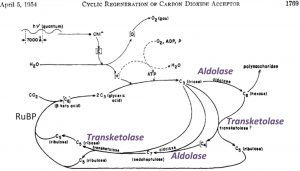 It has been over seventy years since Melvin Calvin and Andrew Benson first started on their journey to discovering the Calvin-Benson cycle – the series of biochemical reactions in which the Sun’s energy is converted to chemical energy stored inside the cells of plants, cyanobacteria and algae. In this very accessible review, Sharkey plots the history of this discovery, as-well-as the relative roles of, and relationships between, Benson, Calvin, and James ‘Al’ Bassham. Of special interest is Sharkey’s description of the leap in knowledge from the earlier incomplete or erroneous pathways requiring the involvement of the tricarboxylic acid cycle, to the canonical Calvin-Benson cycle involving gluconeogenic reactions and carbohydrate metabolism. Sharkey reflects on the original pathway from 1954 by examining data acquired since its discovery, and presents the additional paths of carbon during photosynthesis and Calvin’s flawed thioctic acid theory (as-well-as an important footnote regarding the nomenclature of rubisco!). (Summary by Mike Page) Photosynth Res 10.1007/s11120-018-0600-2
It has been over seventy years since Melvin Calvin and Andrew Benson first started on their journey to discovering the Calvin-Benson cycle – the series of biochemical reactions in which the Sun’s energy is converted to chemical energy stored inside the cells of plants, cyanobacteria and algae. In this very accessible review, Sharkey plots the history of this discovery, as-well-as the relative roles of, and relationships between, Benson, Calvin, and James ‘Al’ Bassham. Of special interest is Sharkey’s description of the leap in knowledge from the earlier incomplete or erroneous pathways requiring the involvement of the tricarboxylic acid cycle, to the canonical Calvin-Benson cycle involving gluconeogenic reactions and carbohydrate metabolism. Sharkey reflects on the original pathway from 1954 by examining data acquired since its discovery, and presents the additional paths of carbon during photosynthesis and Calvin’s flawed thioctic acid theory (as-well-as an important footnote regarding the nomenclature of rubisco!). (Summary by Mike Page) Photosynth Res 10.1007/s11120-018-0600-2
Expert View: The nitrogen cost of photosynthesis (J Exp Bot)
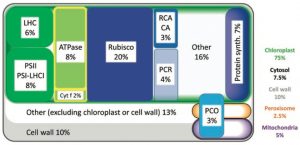 Modern crop production is intimately linked to the availability of nitrogen. Photosynthetic proteins (including rubisco) account for most of the nitrogen in leaves, a significant amount of which is removed during harvesting and must be replenished primarily through the application of synthetic nitrogen fertilisers. In this Expert View, Evans & Clarke revisit the nitrogen budget of a C3 leaf based on modern x-ray crystallography and mass spectrometry data. The authors discuss the difficulties of applying generalised relationships between photosynthesis and leaf nitrogen contents to the ecosystem scale, and consider recent advances in remote sensing to measure some of the required parameters. They then discuss the relationship between carbon assimilation and the synthesis of nitrogenous compounds, and how increasing atmospheric CO2 concentrations will change the nitrogen content of our crops in the future. The manuscript finishes by assessing the nitrogen cost of some of the current strategies for improving photosynthesis, with an emphasis on maintaining current levels of grain protein levels. (Summary by Mike Page) J Exp Bot 10.1093/jxb/ery366
Modern crop production is intimately linked to the availability of nitrogen. Photosynthetic proteins (including rubisco) account for most of the nitrogen in leaves, a significant amount of which is removed during harvesting and must be replenished primarily through the application of synthetic nitrogen fertilisers. In this Expert View, Evans & Clarke revisit the nitrogen budget of a C3 leaf based on modern x-ray crystallography and mass spectrometry data. The authors discuss the difficulties of applying generalised relationships between photosynthesis and leaf nitrogen contents to the ecosystem scale, and consider recent advances in remote sensing to measure some of the required parameters. They then discuss the relationship between carbon assimilation and the synthesis of nitrogenous compounds, and how increasing atmospheric CO2 concentrations will change the nitrogen content of our crops in the future. The manuscript finishes by assessing the nitrogen cost of some of the current strategies for improving photosynthesis, with an emphasis on maintaining current levels of grain protein levels. (Summary by Mike Page) J Exp Bot 10.1093/jxb/ery366
Rate of photosynthetic acclimation to fluctuating light varies widely among genotypes of wheat (bioRxiv)
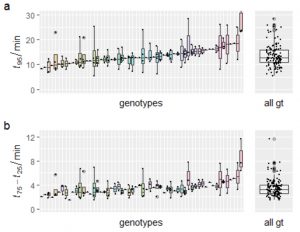 The speed at which photosynthesis is induced during shade-sun transitions, such as sun-flecks, contributes towards determining crop yield. The speed of induction can be limited by the dynamics of stomatal and mesophyll conductance, deactivation rates of photoprotective mechanisms, the acclimation rate of photosynthesis, and the activity of Rubisco activase. Salter et al screened 58 genotypes of field-grown wheat to determine the natural variation in photosynthetic induction. A vs. ci curves revealed that induction of Rubisco carboxylation capacity (Vcmax) lagged behind induction of photosynthetic electron transport (J), indicating that Vcmax is always limiting photosynthesis during shade-sun transitions in the field. There was also large inter-genotype variation in the time taken for the maximum assimilation rate (Amax) to increase through its dynamic range. Simulations were performed indicating that ‘slow induction’ genotypes assimilated approximately 3-4% less carbon each day than ‘fast induction’ genotypes, representing a significant shortfall over an entire growing season. The implications for breeding strategies to improve photosynthetic induction rate were also discussed. (Summary by Mike Page) bioRxiv 10.1101/435834
The speed at which photosynthesis is induced during shade-sun transitions, such as sun-flecks, contributes towards determining crop yield. The speed of induction can be limited by the dynamics of stomatal and mesophyll conductance, deactivation rates of photoprotective mechanisms, the acclimation rate of photosynthesis, and the activity of Rubisco activase. Salter et al screened 58 genotypes of field-grown wheat to determine the natural variation in photosynthetic induction. A vs. ci curves revealed that induction of Rubisco carboxylation capacity (Vcmax) lagged behind induction of photosynthetic electron transport (J), indicating that Vcmax is always limiting photosynthesis during shade-sun transitions in the field. There was also large inter-genotype variation in the time taken for the maximum assimilation rate (Amax) to increase through its dynamic range. Simulations were performed indicating that ‘slow induction’ genotypes assimilated approximately 3-4% less carbon each day than ‘fast induction’ genotypes, representing a significant shortfall over an entire growing season. The implications for breeding strategies to improve photosynthetic induction rate were also discussed. (Summary by Mike Page) bioRxiv 10.1101/435834
Whole plant chamber to examine sensitivity of cereal gas exchange to changes in evaporative demand (Plant Methods)
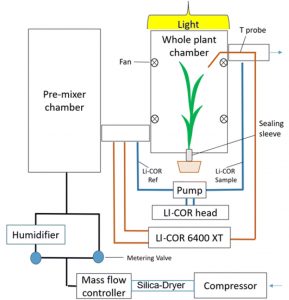 Stomata represent the entry point into the leaf for CO2 that will be fixed by rubisco in photosynthesis and the exit point of water as it is lost to the atmosphere. As such, they are subject to tight regulation in response to the environment so that water loss is minimised and a supply of CO2 is maintained to the site of fixation – the balance between these two flows determines the intrinsic water use efficiency (iWUE). Different plant species show varying responses to changes in the vapour pressure deficit (VPD, the discrepancy between the saturated and actual vapour pressures), but analysis of photosynthetic traits and WUE has been largely limited to leaf-level measurements which may not represent the whole plant. In this manuscript, Jauregui et al describe the design, construction, testing, and use of a whole plant gas exchange system. This system avoids the pitfalls of previous chambers through hardware upgrades that enable tighter control and monitoring of the environment inside the chamber, while allowing the simultaneous measurement of plant iWUE and photosynthetic parameters. The system was used to demonstrate that while transpiration was restricted at high VPD, photosynthesis was not limited in wild-type cereal genotypes. (Summary by Mike Page) Plant Methods 10.1186/s13007-018-0357-9
Stomata represent the entry point into the leaf for CO2 that will be fixed by rubisco in photosynthesis and the exit point of water as it is lost to the atmosphere. As such, they are subject to tight regulation in response to the environment so that water loss is minimised and a supply of CO2 is maintained to the site of fixation – the balance between these two flows determines the intrinsic water use efficiency (iWUE). Different plant species show varying responses to changes in the vapour pressure deficit (VPD, the discrepancy between the saturated and actual vapour pressures), but analysis of photosynthetic traits and WUE has been largely limited to leaf-level measurements which may not represent the whole plant. In this manuscript, Jauregui et al describe the design, construction, testing, and use of a whole plant gas exchange system. This system avoids the pitfalls of previous chambers through hardware upgrades that enable tighter control and monitoring of the environment inside the chamber, while allowing the simultaneous measurement of plant iWUE and photosynthetic parameters. The system was used to demonstrate that while transpiration was restricted at high VPD, photosynthesis was not limited in wild-type cereal genotypes. (Summary by Mike Page) Plant Methods 10.1186/s13007-018-0357-9
Roles of RbcX in carboxysome biosynthesis in the cyanobacterium Synechococcus elongates PCC 7942 (Plant Physiol)
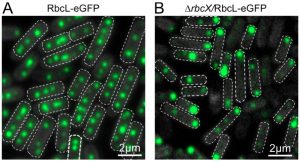 Introduction of the cyanobacterial carboxysome into C3 crops represents a viable strategy to increase photosynthetic conversion efficiency and boost crop yield. Key to this challenge is gaining a full understanding of the carboxysome system in cyanobacteria, including how these microcompartments assemble and function. In this manuscript, Huang et al investigated the role of RbcX, one of the chaperones of rubisco. The authors demonstrated that RbcX was not required for the assembly of rubisco, and surprisingly that rbcX deletion mutants of Synechococcus elongatus PCC 7942 accumulated more, rather than less rubisco. Furthermore, RbcX predominantly co-localised with rubisco inside both mature and newly synthesised carboxysomes, while rbcX mutants had fewer carboxysomes per cell. These data indicate that RbcX may serve a crucial role in carboxysome assembly and stability, and will certainly inform future efforts to engineer carboxysomes into C3 crops. (Summary by Mike Page) Plant Physiol 10.1104/pp.18.01217
Introduction of the cyanobacterial carboxysome into C3 crops represents a viable strategy to increase photosynthetic conversion efficiency and boost crop yield. Key to this challenge is gaining a full understanding of the carboxysome system in cyanobacteria, including how these microcompartments assemble and function. In this manuscript, Huang et al investigated the role of RbcX, one of the chaperones of rubisco. The authors demonstrated that RbcX was not required for the assembly of rubisco, and surprisingly that rbcX deletion mutants of Synechococcus elongatus PCC 7942 accumulated more, rather than less rubisco. Furthermore, RbcX predominantly co-localised with rubisco inside both mature and newly synthesised carboxysomes, while rbcX mutants had fewer carboxysomes per cell. These data indicate that RbcX may serve a crucial role in carboxysome assembly and stability, and will certainly inform future efforts to engineer carboxysomes into C3 crops. (Summary by Mike Page) Plant Physiol 10.1104/pp.18.01217
A thylakoid-located carbonic anhydrase regulates CO2 uptake in the cyanobacterium Synechocystis sp. PCC 6803 (New Phytol)
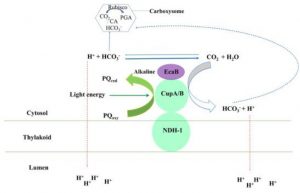 The cyanobacterial CO2 concentrating mechanism (CCM) is dependent on a continuous supply of inorganic carbon (Ci) to rubisco inside carboxysomes in order to function optimally. CO2 uptake pathways are therefore of great importance for a full understanding of the cyanobacterial CCM. Sun et al demonstrate that a thylakoid bound carbonic anhydrase (CA), EcaB, converts CO2 to bicarbonate (HCO3–) as part of both NDH-1 complexes. This beta-CA was shown to bind to the NDH-1 complexes through interaction with CupA and CupB. The precise function of EcaB has yet to be determined due to conflicting pieces of evidence, and it is not conserved across the cyanobacterial lineage. However, its responsiveness to high illumination and CO2 do suggest an important contribution to CO2 uptake. (Summary by Mike Page) New Phytol 10.1111/nph.15575
The cyanobacterial CO2 concentrating mechanism (CCM) is dependent on a continuous supply of inorganic carbon (Ci) to rubisco inside carboxysomes in order to function optimally. CO2 uptake pathways are therefore of great importance for a full understanding of the cyanobacterial CCM. Sun et al demonstrate that a thylakoid bound carbonic anhydrase (CA), EcaB, converts CO2 to bicarbonate (HCO3–) as part of both NDH-1 complexes. This beta-CA was shown to bind to the NDH-1 complexes through interaction with CupA and CupB. The precise function of EcaB has yet to be determined due to conflicting pieces of evidence, and it is not conserved across the cyanobacterial lineage. However, its responsiveness to high illumination and CO2 do suggest an important contribution to CO2 uptake. (Summary by Mike Page) New Phytol 10.1111/nph.15575
Bundle sheath chloroplast volume can house sufficient Rubisco to avoid limiting C4 photosynthesis during chilling (J Exp Bot)
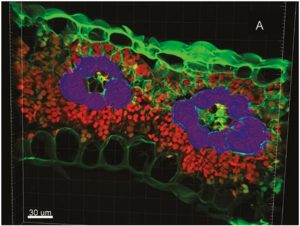 It has long been thought that C4 species generally perform less well than C3 species in cold environments as a consequence of a physical space restriction. C3 species tend to accumulate more rubisco under chilling stress to avoid limiting photosynthesis, but there is less capacity for this in C4 species as rubisco is confined solely to bundle sheath cells (BSCs). Pignon et al investigated this phenomenon by comparing the chloroplast volume and leaf anatomy of a chilling-tolerant C4 species to three chilling-intolerant C4 species. To achieve accurate determination of these parameters, the authors employed 3D confocal imaging of fixed leaf samples with stained cell walls. Surprisingly, chilling-tolerant plants had the smallest BSC chloroplast volume of the four species examined. In addition, calculations of the theoretical maximum rate of rubisco-limited photosynthesis were higher than actual net photosynthetic uptake for chilled plants in all the species tested. These results suggest that BSC volume does not limit photosynthesis in C4 plants growing in cold environments, contradicting the existing hypothesis. (Summary by Mike Page) J Exp Bot 10.1093/jxb/ery345
It has long been thought that C4 species generally perform less well than C3 species in cold environments as a consequence of a physical space restriction. C3 species tend to accumulate more rubisco under chilling stress to avoid limiting photosynthesis, but there is less capacity for this in C4 species as rubisco is confined solely to bundle sheath cells (BSCs). Pignon et al investigated this phenomenon by comparing the chloroplast volume and leaf anatomy of a chilling-tolerant C4 species to three chilling-intolerant C4 species. To achieve accurate determination of these parameters, the authors employed 3D confocal imaging of fixed leaf samples with stained cell walls. Surprisingly, chilling-tolerant plants had the smallest BSC chloroplast volume of the four species examined. In addition, calculations of the theoretical maximum rate of rubisco-limited photosynthesis were higher than actual net photosynthetic uptake for chilled plants in all the species tested. These results suggest that BSC volume does not limit photosynthesis in C4 plants growing in cold environments, contradicting the existing hypothesis. (Summary by Mike Page) J Exp Bot 10.1093/jxb/ery345
BSD2 is a Rubisco specific assembly chaperone, forms intermediary hetero‐oligomeric complexes and is non‐limiting to growth in tobacco (Plant Cell Environ)
 The rubisco holoenzyme is comprised of eight large subunits and eight small subunits (L8S8). Several auxiliary proteins are required to correctly assemble the functional protein. In this manuscript, Conlan et al investigate the chaperone function of one of these proteins, BSD2, in tobacco. The authors confirmed that in leaf tissue, BSD2 forms stable complexes with L8, which may or may not also contain rubisco small subunits. In addition to complexed BSD2, a small amount of uncomplexed protein was also observed, indicating that BSD2 might have additional functions. However, RNAi silencing of BSD2 demonstrated that its only function appeared to be rubisco assembly. BSD2 was specific for Form I rubisco, although BSD2 from tobacco, Arabidopsis and maize were all able to rescue rubisco production in BSD2-RNAi tobacco lines. Over-expression of BSD2 did not lead to increased production of L8S8 rubisco or L8-BSD2, indicating that BSD2 is not normally limiting. The implications of these data for engineering different rubisco isoforms into plants is discussed. (Summary by Mike Page) Plant Cell Environ 10.1111/pce.13473
The rubisco holoenzyme is comprised of eight large subunits and eight small subunits (L8S8). Several auxiliary proteins are required to correctly assemble the functional protein. In this manuscript, Conlan et al investigate the chaperone function of one of these proteins, BSD2, in tobacco. The authors confirmed that in leaf tissue, BSD2 forms stable complexes with L8, which may or may not also contain rubisco small subunits. In addition to complexed BSD2, a small amount of uncomplexed protein was also observed, indicating that BSD2 might have additional functions. However, RNAi silencing of BSD2 demonstrated that its only function appeared to be rubisco assembly. BSD2 was specific for Form I rubisco, although BSD2 from tobacco, Arabidopsis and maize were all able to rescue rubisco production in BSD2-RNAi tobacco lines. Over-expression of BSD2 did not lead to increased production of L8S8 rubisco or L8-BSD2, indicating that BSD2 is not normally limiting. The implications of these data for engineering different rubisco isoforms into plants is discussed. (Summary by Mike Page) Plant Cell Environ 10.1111/pce.13473
Other photosynthesis papers we’re reading this week…
Global vegetation’s CO2 uptake 10.1038/s41559-018-0730-0 (Nat Ecol Evol) $ by Sara Vicca
A genome-wide algal mutant library reveals a global view of genes required for eukaryotic photosynthesis 10.1101/464859 (bioRxiv) by
Revisiting tradeoffs in Rubisco kinetic parameters 10.1101/470021 (bioRxiv) by Avi Flamholz et al
Temperature response of Rubisco kinetics in Arabidopsis thaliana: thermal breakpoints and implications for reaction mechanisms 10.1093/jxb/ery355 (J Exp Bot) by Ryan Boyd et al
C4 photosynthesis and climate through the lens of optimality 10.1073/pnas.1718988115 (PNAS) by Haoran Zhou et al
Efficient 2-phosphoglycolate degradation is required to maintain carbon assimilation and allocation in the C4 plant Flaveria bidentis 10.1093/jxb/ery370 (J Exp Bot) by Myles Levey et al
Subdivision of light signalling networks contributes to cellular partitioning of C4 photosynthesis in maize 10.1101/465872 (bioRxiv) by Ross-William Hendron & Steven Kelly
A LHCB9-dependent photosystem I megacomplex induced under low light in Physcomitrella patens 10.1038/s41477-018-0270-2 (Nat Plants) by Alberta Pinnola et al
A unique supramolecular organization of photosystem I in the moss Physcomitrella patens 10.1038/s41477-018-0271-1 (Nat Plants) by Masakazu Iwai et al


